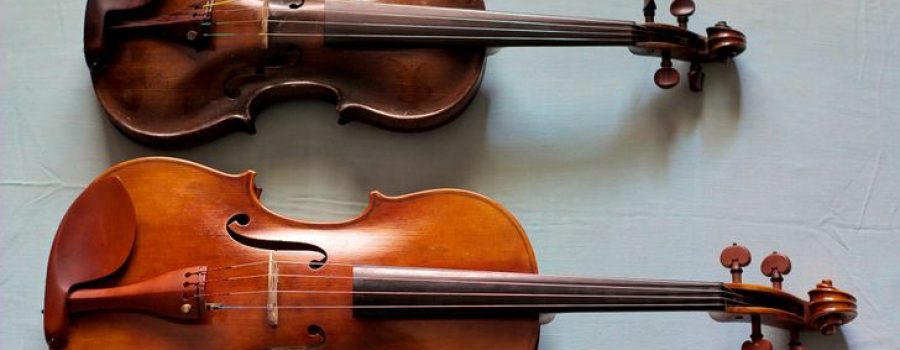The two higher-pitched instruments of a string orchestra – the violin and the viola – have many characteristics in common. The general public, in fact, may even have trouble telling them apart. After all, their basic shapes and colors are very similar; they both have four strings; and they are both carried on a musician’s left shoulder, played with a bow held by the right hand.
Violins and violas are very important instruments in the orchestra. Since they are bowed and not played with air, both can play long melodic phrases. They can also play two notes at a time, called “double stops”, which allow more complex harmonies to evolve from the melody. However, differences between these two instruments are significant. The violin produces the highest pitches. There are more violins in the orchestra than any other instrument (up to 30, depending on the size of the orchestra), and are divided into two groups: first and second. First violins often play the melody, while second violins alternate between melody and harmony.
The Violin
Violins in general often have the melody. If not, they often have an interesting counter melody. So you want to have enough violins to be heard, especially over louder brass instruments. A typical violin is around 24 inches (two feet) long, with a bow that is slightly longer than the instrument itself. You play the violin by resting it between your jaw and left shoulder. Your left hand holds the neck of the violin and presses down on the strings to change the pitch, while your right hand moves the bow or plucks the strings.
The viola is slightly larger and heavier than the violin, requiring the fingers on the left hand to be placed slightly farther apart on the fingerboard while playing. It is also heavier and requires thicker strings and heftier bows. Viola bows weigh about 10 grams more than violin bows. One way to tell a viola bow apart from violin bows is by looking at the frog (the part of the bow that is held by the hand). The frog of the violin bow is pointed, while one on a viola bow is rounded.
The four open strings on both the violin and the viola are tuned to the interval of a perfect fifth apart from one another. The lowest pitch a violin can produce is the first G below middle C, played on an open string. Each consecutive open string that follows is the interval of a perfect fifth above the previous one. Thus the strings on the violin are tuned to the pitches of G, D, A, and E.
The Viola
Three strings on the viola are tuned to the same pitches as those on the violin: the G, D, and A. However, the viola does not have a high E string. Instead, it adds a low C string below the G string. The range of music that the viola plays, therefore, falls right in between the treble and bass clefs. Rather than using both clefs at the same time, viola music is most often notated on an alto clef – with middle C on its center line.
Although this alto clef was used quite widely in the Baroque period, it is rarely used in modern times by instruments other than the viola. The trombone and cello sometimes use the tenor clef, which looks like an alto clef floating one line higher on the music staff. Violists also get to use treble clef on occasion when they play in higher registers. Since the viola is the middle voice in the string section, they have to be masters of articulation. Violas often serve as the mediator between the cellos/basses and the violins.


